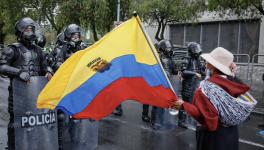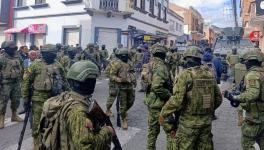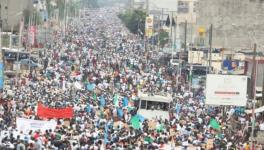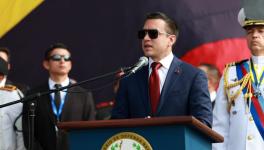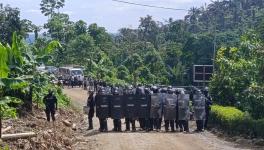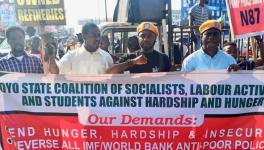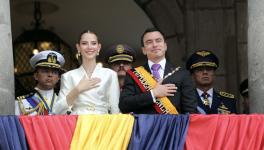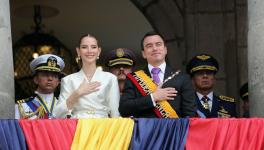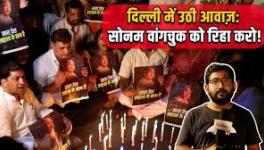Ecuador: Noboa’s Iron Fist Forces End of CONAIE’s National Strike
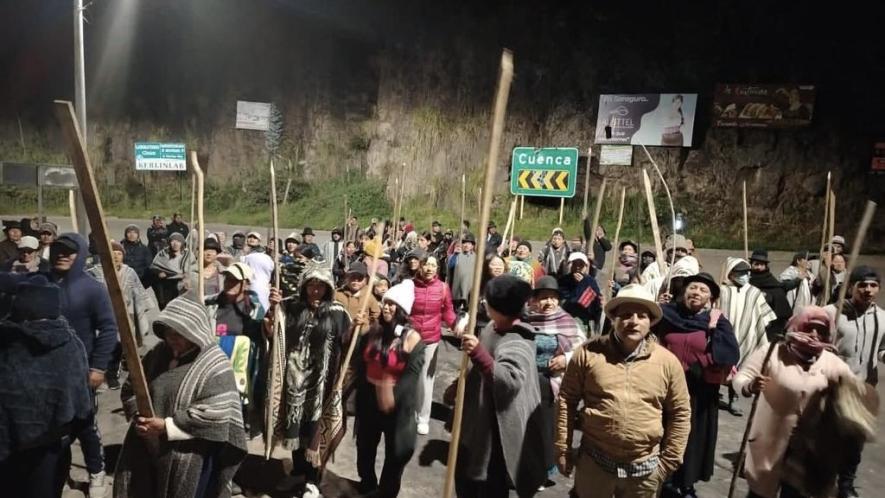
Communities in Saraguro, Ecuador mobilizing as part of the national strike called for by CONAIE. Photo: CONAIE / X
After more than 30 days of demonstrations, roadblocks, military convoys, repression, clashes, marches, sit-ins, and more, the national strike called by the Confederation of Indigenous Nationalities of Ecuador (CONAIE) has ended.
The strike was initially called to protest against the elimination of the diesel subsidy by the right-wing government of Daniel Noboa. Diesel is the most widely used fuel among farmers, peasants, and transporters, and it is also the cheapest.
The CONAIE statement
A few days ago, negotiations between the government and CONAIE were suspended due to a lack of agreement and, according to the government, as a result of the continued roadblocks carried out by several Indigenous communities.
After that, Noboa said he would use all the force of the state to suspend the road closures and clear the highways. Whether or not the president knew that CONAIE would soon announce the end of the strike is something that has caused much speculation in Ecuador. What is certain is that he will have no problem in his intention to reopen the roads once the end of the Indigenous protests has been announced.
The announcement of the end of the national strike was made by CONAIE president Marlon Vargas: “In recent days, we have witnessed brutal repression against our brothers and sisters in several provinces of the country. As a result, there are three dead, dozens injured, and entire communities living in fear and repression. This government has shown that human rights violations do not limit its actions. Faced with this reality, we have made a difficult but necessary decision: to end the strike, clear the roads, and retreat to our territories.”
Vargas justified the decision based on the harshness with which Noboa’s government has acted and its intransigence in reaching agreements that involve the elimination of the subsidy. In this regard, he asked Noboa to respond to the decision: “We ask that all territories of our communities be immediately demilitarized. Order the release of those detained during the demonstrations. Provide care and compensation to the families of those killed and to the injured who still require medical treatment. And finally, stop the persecution of CONAIE leaders.”
In addition, the president of CONAIE, Ecuador’s largest social movement, announced that he will begin preparations for an electoral campaign to reject Noboa and his allies’ attempts to change the constitution, which will be decided in a referendum on November 16. CONAIE announced that it will ask its supporters and allies to vote No, “in defense of the [current] constitution, democracy, and acquired rights. We will promote a broad and participatory campaign.”
The figures from the strike
For more than 30 days, several roads were closed by the Indigenous movement. However, the movement was unable to achieve the same level of cohesion as on other occasions, specifically in 2019 and 2022, when CONAIE, led at the time by Leonidas Iza, severely complicated the governments of Lenín Moreno (2017-2021) and Guillermo Lasso (2021-2023), respectively. Faced with the strength of the Indigenous movement, the latter had to back down on several decisions, such as the elimination of subsidies.
In 2025, things were different. Noboa’s government managed to end the strike without giving in to its demands. It did so with a heavy hand and military strategies never before seen in the interior of the country: the Armed Forces reported that more than 2,000 military operations were carried out in the country, involving more than 12,000 soldiers. (5,000 of whom guarded Quito to prevent a new mass mobilization towards the capital, as happened in 2019 and 2022).
In addition, the government divided the executive branch into two parts, the presidency and the vice presidency, and located them in other cities (Latacunga and Otavalo, respectively). And while it is true that other presidents have done this before, Noboa’s government managed to avoid something fundamental: Indigenous mobilizations reaching Quito, the capital.
It did so by restricting free movement and stationing the army at the entrance to the city. This is crucial if we look at the recent history of mass protests, which had a greater impact precisely because they disrupted the normal functioning of the capital, the second most populous city in the country, and where the public functions of the state are concentrated.
In contrast, in 2025, the demonstrations did not concentrate with particular force in a single place, but were decentralized, especially in Imbabura, where the most important demonstrations took place and where there were more clashes.
In 2025, the death toll has been lower compared to previous national strikes. In 2025, three people died, while in 2019 nine people died, and in 2022 ten. In terms of injuries, the Alliance of Human Rights Organizations reported that in 2025, 296 protesters were injured, and 15 people are missing. The security forces, for their part, said that 49 soldiers and 24 police officers were injured. These figures are also lower than those for 2019 and 2022.
In addition, following the 2025 strike, 205 arrests were reported, which are awaiting sentencing. Protesters fear that the prosecution will use the legal concept of “terrorism,” which could result in imprisonment for more than 15 years.
Meanwhile, Reporters Without Borders affirmed that there had been 55 attacks on journalists: “Reporters Without Borders (RSF) strongly condemns the serious escalation of violence against journalists in Ecuador during the national strike. At least 55 journalists have been attacked since September 22, the most recent case being that of Apak TV journalist and producer Edison Muenala, who was seriously injured. RSF calls for an immediate response and the implementation of effective protection measures to ensure that media professionals are not attacked while doing their job.”
An absolute victory for Noboa?
Many have seen CONAIE’s latest decision as a clear defeat for the Indigenous movement and, consequently, a victory for Noboa’s neoliberal government, which seeks to strictly comply with the program imposed by the International Monetary Fund. Indeed, Noboa, unlike his predecessors, managed to uphold his decision, at least for now.
However, many analysts wonder how much this victory really cost Noboa. In this regard, many believe that the answer to this question will be revealed in the upcoming referendum, which can be seen, among other things, as a way of gauging popular support for the government. Both Moreno and Lasso ended their terms completely exhausted, politically speaking. It is not surprising to think that national strikes are also a test from which presidents emerge deeply worn down.
For the moment, the government is celebrating its victory and the Indigenous movement is retreating, but not without several internal criticisms within CONAIE demanding that the demonstrations and roadblocks continue until another result is obtained. Moreover, some groups have announced that they will not cease their actions against the government.
Courtesy: Peoples Dispatch
Get the latest reports & analysis with people's perspective on Protests, movements & deep analytical videos, discussions of the current affairs in your Telegram app. Subscribe to NewsClick's Telegram channel & get Real-Time updates on stories, as they get published on our website.










